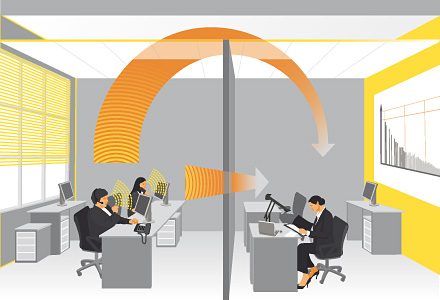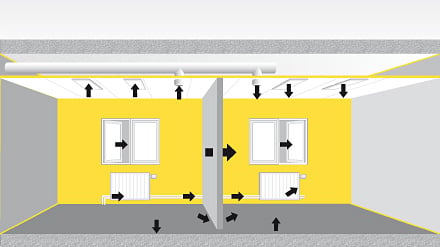Room-to-room insulation
 If partitions do not reach the structural soffit a horizontal transmission path for the sound via the void over the suspended ceiling is created. Therefore, traditional acoustic ceilings often provide insufficient sound insulation. In these cases special acoustic ceiling systems are required which offer additional sound insulating properties.
If partitions do not reach the structural soffit a horizontal transmission path for the sound via the void over the suspended ceiling is created. Therefore, traditional acoustic ceilings often provide insufficient sound insulation. In these cases special acoustic ceiling systems are required which offer additional sound insulating properties.
The continuous suspended ceiling is chosen in order to achieve maximum flexibility. However these constructions will give lower sound insulation compared to constructions where the partitions are allowed to penetrate the suspended ceiling or reach all the way up to the soffit.
When estimating the airborne sound insulation:
-
consider the whole structure
-
note that on site values are lower than laboratory values
Laboratory value/site value
In practice on site, the room-to-room sound insulation (R′w) can be estimated to be 5-8 dB lower than the lowest value in laboratory for the suspended ceiling and partition respectively. This is due to the fact that flanking transmission might occur and some installation details might not be perfect.
Room-to-room sound insulation values
Laboratory value Dn,f,w according to ISO 10848-2 and evaluation according to EN ISO 717-1.
|
D n,f,w |
Product and size |
|
43 dB |
Combison Duo A, 600x600 mm |
|
39 dB |
Combison Duo E, 600x600 mm |
|
43 dB |
Combison Uno A, 600x600 mm |
|
41 dB |
Combison Uno Ds, 600x600 mm |
|
42 dB |
Combison A, db 42, 1200x600 mm |
|
28 dB |
Master A, 1200x600 mm |
|
29 dB |
Master E, 1200x1200 mm |
|
31 dB |
Master Ds, 600x600 mm |
Improvement of laboratory value Dn,f,w when adding Combison Barrier or Combison XR.
| Improvement | Product |
|
+4 |
Combison + 1x40 Barrier |
|
+8 |
Combison + 2x40 Barrier |
|
+3 |
Combison + 2x1200 XR |
|
+6 |
Combison + 100% XR |
Note that site result will be 5-8 dB lower than laboratory value.
Recommendations

Different transmission paths between rooms.
In order to provide reasonable privacy we recommend that normal offices have sound insulation between adjacent rooms of R′w = 35 dB. This requires a suspended ceiling with a laboratory value Dn,f,w > 40 dB.
The general approach is to combine a sound insulating suspended ceiling with partitions that offer at least the same sound insulation value in a laboratory. Other transmission paths, i.e. ventilation systems, should have an even better sound insulation value.
The values used for the suspended ceiling and the partition should also include possible installations into them, such as lighting and ventilation units or doors and windows. It’s crucial to prevent leakage due to e.g. incomplete sealed junctions between separating wall and flanking surfaces, continuous cable tray or openings around different construction details.
